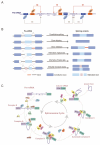The Intricate Functional Networks of Pre-mRNA Alternative Splicing in Mammalian Spermatogenesis
- PMID: 39596142
- PMCID: PMC11594017
- DOI: 10.3390/ijms252212074
The Intricate Functional Networks of Pre-mRNA Alternative Splicing in Mammalian Spermatogenesis
Abstract
Spermatogenesis is a highly coordinated process that requires the precise expression of specific subsets of genes in different types of germ cells, controlled both temporally and spatially. Among these genes, those that can exert an indispensable influence in spermatogenesis via participating in alternative splicing make up the overwhelming majority. mRNA alternative-splicing (AS) events can generate various isoforms with distinct functions from a single DNA sequence, based on specific AS codes. In addition to enhancing the finite diversity of the genome, AS can also regulate the transcription and translation of certain genes by directly binding to their cis-elements or by recruiting trans-elements that interact with consensus motifs. The testis, being one of the most complex tissue transcriptomes, undergoes unparalleled transcriptional and translational activity, supporting the dramatic and dynamic transitions that occur during spermatogenesis. Consequently, AS plays a vital role in producing an extensive array of transcripts and coordinating significant changes throughout this process. In this review, we summarize the intricate functional network of alternative splicing in spermatogenesis based on the integration of current research findings.
Keywords: alternative splicing; male infertility; spermatogenesis.
Conflict of interest statement
The authors have declared that no competing interest exists.
Figures


References
Publication types
MeSH terms
Substances
Grants and funding
LinkOut - more resources
Full Text Sources
Research Materials

